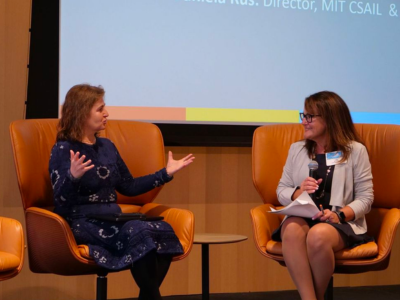On May 21st, 2024, the MIT Technology Review hosted Future Compute, or what they call the “executive classroom for digital leadership.” Created to offer business executives strategic vision and a deep understanding of emerging technologies, this year’s event focused on implementing AI tools, digital transformation and workforce management, and adapting existing infrastructure for a changing technological landscape.
Here are some key takeaways from the event.
- It’s no secret that generative AI is one of the most exciting technological advancements of the last few years. But here are some things to keep in mind when considering this groundbreaking technology:
- It’s critical for generative AI tools to be robust and trustworthy before these models are interacting with customers or making business-critical decisions. In most cases, that comes down to having and using the right training data.
- IT departments will need to be flexible and adapt to new challenges and threats when it comes to generative AI.
- One way to think about generative AI is that it gives people the power of the first draft, offering quick ways to iterate and innovate and lowering the barrier to entry in a variety of fields, including software development, content creation, data analysis, and more.
- Artificial Intelligence in general is, as Dean of the MIT Schwarzman College of Computing Dan Huttenlocher put it, a funhouse mirror, reflecting certain elements of the user and/or developer depending on several factors.
- Based on how it’s trained and implemented, AI can either make decisions better and fairer or reinforce errors and biases. Thus, we need to be proactive about designing AI that is collaborative and empowering from the ground up.
- AI has certain strengths where it outperforms humans, such as processing giant volumes of data or running simulations to gain insights that people might miss. However, it cannot make moral or value judgements, it is not fully reliable in most applications, and it is not inherently creative.
- Excitingly, AI has the capacity to revolutionize life sciences, chemical discovery, protein understanding, clinical practice, and other areas where there are vast amounts of data and experts with limited bandwidth or time.
When it comes to cybersecurity, AI will both improve the scalability of bad actors and help prevent attacks through pattern detection, identifying novel attacks, and accelerating the ability to contain and mitigate vulnerabilities.

- The success or failure of implementing AI tools will depend in part on how they are introduced to employees, colleagues, and collaborators. If workers are invited into the conversation and included in the strategy dialogue, there’s a greater chance of buy-in and uptake of these technologies. But if pressured through top-down dictates to begin using AI tools, such tools are unlikely to have a positive effect and could even prove detrimental to business practices.
- Some business leaders spoke about forming an AI Council or some kind of AI oversight which could strategize about AI implementation from the beginning, consider the various challenges from the outset, and build a road map that takes all elements of AI adoption into consideration.
Around many of these topics—AI adoption, cybersecurity, efficiency—workplace culture is a defining factor of success. Encouraging company-wide conversations and making space for innovation, continuing education, and upskilling are good ways to keep technological progress at the forefront of company strategy.

- Due to the importance of data in training useful AI, curating and managing enterprise data will become even more important than it has been in the past.
- One potential trend in the coming years will be spatial dynamics, in which computers begin to understand and interact with the physical world. This promises to fundamentally change human-computer-interaction and could have implications for remote work, factory management, advertising, entertainment, etc.
- Sustainability and cost management are two challenges already surfacing as businesses try to adapt and update their technology, particularly when it comes to AI and cloud storage. One strategy to minimize costs and unnecessary waste is to consider efficiency from the beginning, building a strategy that includes that as a goal.
The technology market is changing rapidly, and that pace of progress appears to only be speeding up. For that reason, it’s important for leaders, innovators, and strategic thinkers to be aware of breakthroughs as they happen, to structure their enterprise culture to be dynamic and flexible, and to constantly be iterating intelligently for the best possible customer experience.
To stay up to date with groundbreaking MIT computer science research, reach out to CSAIL Alliances at alliances@list.csail.mit.edu.


